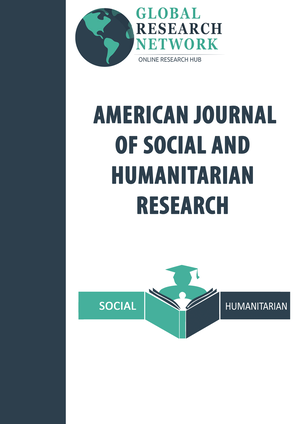Sincere Devotion (Ikhlas) and Honor (Izzah) as Protective Factors Against People-Pleasing Behavior: An Islamic Perspective on Authenticity and Adolescent Well-Being
Abstract
Keywords
Full Text:
PDFReferences
J. W. Santrock, Life-span development, 16th ed. New York, NY: McGraw-Hill, 2018.
J. D. Miller, D. R. Lynam, and W. K. Campbell, “The dark side of agreeableness: Examining people-pleasing behavior and psychological costs,” Personal. Individ. Differ., vol. 162, p. 110037, 2020, doi: 10.1016/j.paid.2020.110037.
M. R. Leary and R. M. Kowalski, Social anxiety. New York, NY: Guilford Press, 1995.
J. Crocker and L. E. Park, “The costly pursuit of self-esteem,” Psychol. Bull., vol. 130, no. 3, pp. 392–414, 2004, doi: 10.1037/0033-2909.130.3.392.
M. Rosenberg, Society and the adolescent self-image. Princeton, NJ: Princeton University Press, 1965.
J. M. Twenge and W. K. Campbell, “Associations between screen time and lower psychological well-being among children and adolescents: Evidence from a population-based study,” Prev. Med. Rep., vol. 12, pp. 271–283, 2018, doi: 10.1016/j.pmedr.2018.10.003.
I. Beyens, J. L. Pouwels, I. I. van Driel, L. Keijsers, and P. M. Valkenburg, “The effect of social media on well-being differs from adolescent to adolescent,” Sci. Rep., vol. 10, no. 1, p. 10763, 2020, doi: 10.1038/s41598-020-67727-7.
E. L. Deci and R. M. Ryan, “Self-determination theory and the facilitation of intrinsic motivation, social development, and well-being,” Am. Psychol., vol. 55, no. 1, pp. 68–78, 2000, doi: 10.1037/0003-066X.55.1.68.
M. Yusuf and N. Rahmah, “The role of Islamic parenting in developing children’s emotional and spiritual intelligence,” Int. J. Islam. Stud. Educ., vol. 4, no. 1, pp. 45–60, 2022, doi: 10.1234/ijise.v4i1.789.
I. Nurhidayati, “Internalisasi nilai ikhlas dalam pendidikan anak: Studi pemikiran Al-Ghazali,” J. Pendidik. Islam, vol. 12, no. 1, pp. 23–38, 2017, doi: 10.14421/jpi.2017.121.23-38.
S. Farihah, “Konsep izzah dalam Al-Qur’an dan relevansinya dengan pendidikan karakter,” J. Tarb., vol. 26, no. 2, pp. 155–172, 2019.
Al-Ghazali, Ihya’ Ulum al-Din. Beirut: Dar al-Kutub al-‘Ilmiyyah, 1997.
M. N. Ghufron, “Pengaruh pola asuh Islami terhadap pembentukan self-esteem pada remaja,” J. Psikol. Islam, vol. 7, no. 1, pp. 45–60, 2020, doi: 10.21580/jpi.2020.7.1.123.
B. Markway and C. Ampel, The disease to please: How to stop people-pleasing and start living. New York, NY: HarperCollins, 2021.
A. Abdullah, “Islamic education and character development: Nurturing faith and resilience in Muslim youth,” J. Islam. Educ. Stud., vol. 9, no. 2, pp. 101–118, 2021, doi: 10.1234/jies.v9i2.2021.
B. Keles, N. McCrae, and A. Grealish, “A systematic review: The influence of social media on depression, anxiety, and psychological distress in adolescents,” Int. J. Adolesc. Youth, vol. 25, no. 1, pp. 79–93, 2020, doi: 10.1080/02673843.2019.1590851.
D. P. Sari and S. Wahyuni, “Media exposure and identity negotiation among Muslim adolescents in the era of globalization,” J. Psikol. Islam, vol. 8, no. 2, pp. 145–160, 2021, doi: 10.21580/jpi.2021.8.2.456.
S. Ali and R. Hassan, “Rethinking Islamic pedagogy: Beyond compliance towards autonomy,” Int. J. Islam. Pedagogy, vol. 5, no. 1, pp. 45–62, 2021, doi: 10.5678/ijip.v5i1.321.
H. Snyder, “Literature review as a research methodology: An overview and guidelines,” J. Bus. Res., vol. 104, pp. 333–339, 2019, doi: 10.1016/j.jbusres.2019.07.039.
J. W. Creswell and C. N. Poth, Qualitative Inquiry and Research Design: Choosing Among Five Approaches, 4th ed. Thousand Oaks, CA: Sage Publications, 2018.
G. A. Bowen, “Document analysis as a qualitative research method,” Qual. Res. J., vol. 9, no. 2, pp. 27–40, 2009, doi: 10.3316/QRJ0902027.
A. Fink, Conducting research literature reviews: From the internet to paper, 5th ed. Thousand Oaks, CA: SAGE, 2020.
C. Hart, Doing a literature review: Releasing the research imagination, 2nd ed. London: SAGE, 2018.
J. J. Randolph, “A guide to writing the dissertation literature review,” Pract. Assess. Res. Eval., vol. 14, no. 13, pp. 1–13, 2009, doi: 10.7275/b0az-8t74.
V. Braun and V. Clarke, “Using thematic analysis in psychology,” Qual. Res. Psychol., vol. 3, no. 2, pp. 77–101, 2006, doi: 10.1191/1478088706qp063oa.
G. Terry, N. Hayfield, V. Clarke, and V. Braun, “Thematic analysis,” in The SAGE handbook of qualitative research in psychology, C. Willig and W. Stainton-Rogers, Eds., London: SAGE, 2017, pp. 17–36.
Y. S. Lincoln and E. G. Guba, Naturalistic inquiry. Newbury Park, CA: SAGE, 1985.
D. Silverman, Interpreting qualitative data, 6th ed. Thousand Oaks, CA: SAGE, 2020.
J. C. Greene, Mixed methods in social inquiry. San Francisco, CA: Jossey-Bass, 2007.
E. H. Erikson, Childhood and society, Rev. ed. New York, NY: W. W. Norton, 1993.
DOI: http://dx.doi.org/10.52155/ijpsat.v54.1.7586
Refbacks
- There are currently no refbacks.
Copyright (c) 2025 Sukma Jaya, Abdul Haris

This work is licensed under a Creative Commons Attribution 4.0 International License.



















